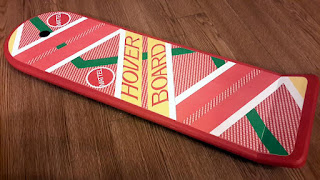Hoverboard
The Hoverboard from "Back to the Future Part 2" is one of the most recognizable movie props. That means, I want to have one.
Quite a few people have done this before, so there is plenty of information that can be found on the web. In particular, there is one thread at "therpf.com", which is just about building BTTF Hoverboard replicas which has a lot of information. A lot of examples can also be found on YouTube. I found the video from the DIY prop shop very helpful, especially since they also provided images of the decals for the front and back sides at dropbox.
These are the ones that I use. Using the open source desktop publishing software Scribus, I converted the original decals into three letter-sized sheets for each, the front and the back side of the board. For copyright reasons, the original decals are missing the brand name "MATTEL" at two places on the front side of the board. I added these in Scribus using the Arial font (make sure to adjust the spacing between the letters, to connect the two Ts). My modified decals are printed on letter-sized cardstock (which is easier to glue to wood, as compared to thin paper).
At different places, one can find slightly different information on the measures of the board. Some suggest a size of 28" x 8" x 1" with the back piece at an angle of 25 degrees. I found that with a thickness of 1", a wooden board would be much too heavy, so I decided to make it 3/4" thick. My printouts of the decals has a total size of 24 1/2" x 7", so when adding 1/2" all around, I get a total size 25 1/2" x 8" x 3/4". The back piece (3" = 2 1/2" decal + 1/2" border) is mounted at an angle of 22 degrees. This is achieved by cutting the full board with a cut at 11 degrees angle and flipping the back piece. The two pieces are glued using E6000 using the following setup.
The edges of the board are sanded to get a nice curvature and smaller details are smoothed using wood filler. The outer 1" area of the board is then painted red (I love the acrylic paints from Apple Barrel, here I used their Bright Red).
Then the decals are glued to the board. I used a credit card to distribute the fast drying "Tacky Glue" in a thin layer evenly over the cardstock.
Then the decals are glued to the board. I used a credit card to distribute the fast drying "Tacky Glue" in a thin layer evenly over the cardstock.
The pieces for the bottom side and the rotating disk on the top are made from 3/16" plywood using a laser cutter. On the bottom, the original movie prop has two cylindrical disks. I approximate these using three layers of round disks of 6", 5 1/4", and 4 1/2". The rotating disk for the top side is made of two layers of plywood, with cutouts that allow to mount the strap. Everything is then painted, and sealed using Mod Podge.
The result looks great. Of course, it should always be carried together with Grays Sport Almanac and Marty's color-changing cap.
Hoverboard Charger
In the movie we do not see how the Hoverboard is charged. But since I needed a stand, I decided to design it as a charging station, with a little Arduino-based electronics. The pieces are cut from 3/16" plywood using a laser cutter.
At the bottom, there is a microswitch which detects when the board is placed on the charger.
In that case, the 10-bar LED battery level display cycles through four different patters. This is seen in the video in the top of this blog.
Related
My other blog posts on BTTF-related props and pieces:- Building a Flux Capacitor
- Building the Time Circuits
- Building BTTF clocks
- Building a BTTF Brick Stage (featuring the smallest Flux Capacitor)


















































